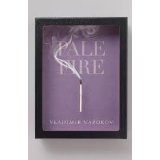 Based solely on the Table of Contents (Forward, Poem, Commentary) you might assume you're in for a dry academic study of a poet’s work. This is the book’s veneer. Once peeled away, an exhilarating story unfolds. Pale Fire is written, first person, by one Charles Kinbote, a native of Zembla, now living in New Wye,
Based solely on the Table of Contents (Forward, Poem, Commentary) you might assume you're in for a dry academic study of a poet’s work. This is the book’s veneer. Once peeled away, an exhilarating story unfolds. Pale Fire is written, first person, by one Charles Kinbote, a native of Zembla, now living in New Wye,
Next door lives our celebrated poet, John Shade. He writes a 999-line poem he entitles Pale Fire – stirring verse full of poignant imagery, double entendres, brilliant puns and word games. (As a rule, I deplore poetry; but this is fantastic stuff.) Shade dies; the manuscript falls (you’ll learn how) to Kinbote. He writes the accompanying Forward and Commentary and finds a publisher.
This is that book.
Initially you might think Kinbote will be the ideal critic for Shade’s poem; in the course of their budding friendship, the two minds (Kinbote alleges) became twin souls.
But our smug émigré spends more time telling us about his Zemblan homeland than about Shade’s poem. Kinbote claims that he often entertained Shade with stories about Zembla and about the revolution that led to its king’s imprisonment. It was after this that Shade began work on his epic poem, Pale Fire. For this reason, Kinbote assumes Shade’s poem would focus on Zembla. Instead, Shade wrote about life and family. Indeed, you begin to suspect Shade never intended to have the poem published! Kinbote fails to see this; he’s too preoccupied with inventing clever connections between his own vain and self indulgent telling and Shade’s verse.
The similarities are strained at best. Or are they? At times it seems Shade may have indeed buried Zemblan themes deep in his writing. Kinbote is so persuasive. Zembla’s king escapes from the bloody revolutionists, ends up in France
Kinbote continues to use Shade’s poem as a springboard for an engrossing story of Zembla and its monarch, all the while, says Kinbote, corresponding to verse from the poem, if not in content, at least chronologically. For as Shade was filling out index card number 243, which would become lines 740 to 748 in canto four, the brute was boarding a plane bound from Paris to a quiet little countryside in New Wye.
The day Shade completes his poem he accompanies his neighbor Kinbote to the fellow don’s rented house, manuscript in hand, perhaps planning a toast. On Kinbote’s porch, so Kinbote says, both poet and admirer are met by Gradus, who draws his revolver, fires at our fugitive king Kinbote, but hits the genius Shade instead. This is actually Jack Grey escaped from the asylum, seeking his revenge on Judge Goldsworth. But Kinbote doesn't seem to make the connection, though he does allow that Shade resembles the judge.
Kinbote reports that he later visited the assassin in prison and that the man pretended he’d never heard of King Charles II of Zembla. Nor would he acknowledge he’d been sent on a mission to assassinate him. A thug, but a loyal thug, Kinbote decides.
But is Kinbote really a fugitive king? Does Zembla even exist?
The book is full of literary gems and jests like these. You’ll enjoy uncovering what appears to be the façade only to discover a dream. Innuendo rushes along just beneath the lines, and once you’ve finished reading the witty Index, you’ll want to go back and do it all over again. Certainly one of the best books I’ve read. Subtle. Amusing. Brilliant.



No comments:
Post a Comment